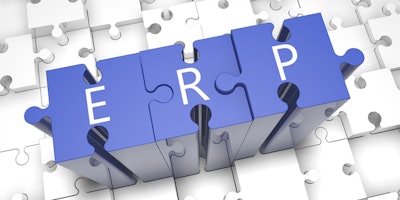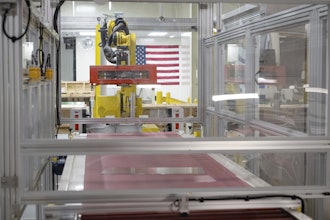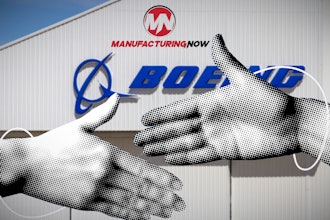
IFS
W
h
it
e
pa
pe
r
Selecting erp
for performance-
BaSed logiSticS
contracting
content
dod’S preferred approach .................................................................................... 1
requirementS of pBl .............................................................................................. 3
BaSic functionality required ............................................................................... 4
hoW to prepare ....................................................................................................... 5
pBl WiSdom .............................................................................................................. 5
1
Selecting eRP foR PeRfoRmance-BaSed logiSticS contRacting
Selecting erp for performance-
BaSed logiSticS contracting
By Dan norrish
Vice PresiDent
iFs north america
Major suppliers and systems integrators working within the military are already
getting involved in performance-based logistics (PBL) contracts. Performance-based
logistics is a different way of doing business. It is a logistics support solution that
shifts traditional DoD inventory, supply chain, asset sustainment, and technical
support functions to the supplier for a guaranteed level of performance at the same
or reduced cost. Even middle-market and smaller suppliers are beginning to address
PBL contracting as the military accelerates its move toward this innovative and
efficient way of systems acquisition and sustainment.
These contracts will increase the involvement of suppliers in services delivered
after the sale, placing new demands on business systems that were not designed for
this type of business model. Suppliers will need to invest in new technology designed
to help them profitably meet the requirements of PBL contracts.
dod’S preferred approach
The PBL business model is the government’s preferred approach for implementing
product support. The overall goal of PBLs is to optimize system readiness. The
supplier is required to meet support goals for a weapon system by establishing a
support structure based on performance metrics with clear lines of authority and
responsibility. The supplier performs logistics functions that have been historically
performed by government personnel while implementing commercial best practices.
PBL contracts augment the support of weapon systems by employing the purchase
of system support as an integrated performance package.
In other words, when the Air Force buys a fighter jet from a supplier, it doesn’t
simply pay for the physical product. Instead, the Air Force has a performance-based
contract with the supplier. This contract’s bottom line is that the Air Force reimburse-
ment to the supplier is contingent on the jet’s performance; how often the jet is able
to fly.
PBL is a support strategy that helps the military quantify and plan for costs by
contracting with vendors not just for purchased assets, but replenishment or even
maintenance, repair and operations of those purchased assets. PBL is a support
strategy that covers a spectrum of support services that a branch of the military may
contract from a supplier in order to optimize support for the asset.
2
Selecting eRP foR PeRfoRmance-BaSed logiSticS contRacting
What this means to military vendors and contractors is that an asset or asset
component supplier may contract to take on some of the maintenance or support
roles traditionally handled directly by military personnel. In some cases, military
staff and civilian contractors may work side-by-side within a depot to support that
craft. In other cases, support may be provided entirely by the supplier. The supplier
might be paid on a performance-based contract for scheduled or non-scheduled
maintenance on an aircraft engine or other components or a whole craft, while
keeping performance readiness at a determined level.
PBL represents a change from the traditional approach, under which the military
was primarily concerned with what to buy, to a new paradigm where the focus is on
who to buy from – what kind of services are required to get the most value out of
what is purchased. For each program, the military is asking itself “what are the
performance goals for this contract? Should we be buying material and support of
that material, support, service for inventory – or complete asset sustainment from
the supplier?”
In the past, this support and maintenance work was done directly by military
personnel, and cost-cutting was done organically through Base Realignment and
Closure of military depots and facilities. But as the potential to realize actual
savings from further closings diminished, the military began to seek new efficiencies
and cost reductions; PBL is being recognized as one such solution.
The number of PBLs has increased over the last five to ten years and will continue
to increase in the future. The military is still learning from existing PBL contracts
how to best use this tool, and contractors are also learning how to better support
PBL contracts.
PBL contracts can be simple or complex, but all require ongoing involvement by
a supplier. A PBL contract could be as simple as involving the supplier in managing
inventory. Others might extend to contractor logistics support (CLS), where the
supplier takes more responsibility for inventory and offers some additional level of
sustainment.
Some PBLs go so far as to include total system program responsibility, with a
supplier taking over entire sustainment process from inventory to asset management.
Suppliers may not need to install an entirely new enterprise resources planning
(ERP) system, particularly if their ERP backbone is modern enough to easily inte-
grate with third-party functionality designed to facilitate PBL-related processes.
Remember that PBL contracts represent a full spectrum of involvement that can be as
limited as direct vendor delivery management. This means that the supplier is main-
taining the inventory on the manufacturing floor, and supplying raw components or
materials on the depot site. In this case, all that may be needed is an inventory
management costing module and some type of scorecard to record the metrics. But
to support ongoing PBL contracts, suppliers should make sure that their ERP func-
tionality can be augmented and expanded as their role changes and grows over time.
3
Selecting eRP foR PeRfoRmance-BaSed logiSticS contRacting
requirementS of pBl
Already, tier one or tier two military suppliers are getting involved in PBL contracts,
earning not only a margin for the sale of the asset but for services performed over
the life of the asset that might extend five, 10, 20, 30 or even 40 years. They are able
to take their knowledge of the asset and its configuration, and the fact that they
have access to parts and other supplies, and turn it into recurring revenue under the
PBL.
But before suppliers serving the military can realize this new revenue, they will
have to assess whether their internal manufacturing or maintenance processes and
systems can support the external services required for PBL. Suppliers may find they
need a separate system from the rest of the operation for data integrity and security.
Systems required to profitably deliver on a PBL contract also require advanced
functionality for predictive maintenance, risk management and service management.
Addressing the need for this new technology is difficult because the defense
supplier industry is, by nature, very conservative. They tend to replace their infor-
mation systems less frequently than companies in other commercial marketplaces.
So even with the promise of additional revenue from PBL contracts, many execu-
tives in this industry will be reticent to either replace their legacy IT systems with
technology flexible enough to integrate with additional PBL-based tools, or aug-
ment existing ERP systems with specialized software tools. Those that try to use an
information system designed for a manufacturing environment to manage ongoing
sustainment, particularly in the areas of maintenance or asset management, risk
either losing money on those PBL contracts or finding that they are not equipped to
deliver as promised.
When trying to force a manufacturing business system to support PBL, one
common problem spot is the bill of materials. A manufacturing bill of materials is
very different from a maintenance bill of materials. The manufacturing bill of
materials looks like a pyramid, and is used in essence to build things up to the pre-
defined end point of the manufacturing process. A maintenance bill of materials has
to be more dynamic, with multiple bills of materials and multiple options depending
on the defect and the maintenance plan. That is a significant difference that can
hamstring efforts to deliver on PBL contracts.
Two other issues that can prevent a manufacturer with an older legacy system not
designed for PBL from succeeding in this space are the need to isolate government
data from internal processes, and a lack of deep maintenance functionality down to
the component level. There are specific requirements regarding data security and
privacy that the military puts forward, along with the requirement that inventory
used on government contracts be kept separate from other inventory, even if it is
identical. Powerful maintenance functionality is required as suppliers get involved
in sustaining equipment over time. because they need to develop predictive mainte-
nance programs not only for the asset as sold, but for the various components they
4
Selecting eRP foR PeRfoRmance-BaSed logiSticS contRacting
may have purchased from external suppliers or subcontractors. All of the work
necessary to sustain the asset needs to be costed during contract negotiations and
managed on an ongoing basis over the life of the contract.
BaSic functionality required
When it comes to the technology used to support a PBL contract, the ability to
handle change over time is critical, not only for the PBL-related software function-
ality but for the manufacturing software functionality with which it is integrated.
PBL contracts tend to change and become complex over time, moving from lim-
ited toward deeper vendor involvement. Moreover, change in the PBL environment,
as is the case across the aerospace and defense market, is driven by the customer
rather than by the vendor companies. This means that suppliers working in a PBL
environment can expect to be asked by their government agency customers to make
changes to their business practices, and ought to have a plan for how the technology
underpinning these practices can keep up.
But perhaps the most challenging element of PBL for most suppliers will be the
challenge of predicting the total cost of the PBL contract from a risk management
standpoint. Larger system integrators and defense suppliers do a good job of assessing
total cost and risk involved in PBLs. One lesson to take from their early experience
is that the better engineering information captured on the asset and its projected
reliability and maintenance costs, the better data there will be to work with when
undertaking that analysis. Suppliers engaging in PBLs will not only need asset life-
cycle data on their own contribution to their finished products, but for all of the
purchased components that are part of their product. And they will not only be
called on to service parts they can get to by opening a panel, but other parts that
require a separate teardown by a subcontractor and supplier. Only by collecting
detailed information on reliability, engineering and the level of effort involved in
sustaining the entirety of the asset can the supplier define the risk of sustaining that
asset and what PBL should be a part of cost negotiations with the military.
This means that as part of their ERP and PBL systems, suppliers will need
strong configuration management tool so they can track the lifing and maintenance
parameters of any part in that asset. Suppliers must further be able to predict main-
tenance costs given the environment the asset is operated in, whether that environ-
ment is a desert, a Midwest winter, or an aircraft carrier, given a certain number of
hours, cycles, thrust and other parameters.
If a supplier underestimates the level of effort required under a PBL contract,
they certainly will lose money. But suppliers that do capture the required asset
sustainment information can make a better margin and meet their PBL metrics.
Moreover, data from one PBL can be replicated and used to enhance and improve
pricing and performance in negotiations for subsequent contracts.
5
Selecting eRP foR PeRfoRmance-BaSed logiSticS contRacting
hoW to prepare
Supplier’s intent on getting involved with PBL will first need to audit their existing
technology infrastructures. It is entirely possible that, if their existing ERP environ-
ment is relatively new and facilitates integration through a modern service oriented
architecture (SOA) that third-party PBL-specific functionality can be integrated
with their existing systems. If the supplier is relying on a patchwork or point
solutions, or is running a dated enterprise-wide system, complete system replace-
ment may be unavoidable.
Suppliers in a position to simply add-on PBL functionality can get up and running
rapidly because they will not have to disrupt their existing systems and processes to
implement this technology. Since they had not likely been undertaking PBL work
before, they are spared the disruption that comes with replacing one way of doing
things with another. But with few exceptions, even very elaborate ERP solutions
like those from SAP and Oracle will need to be augmented with additional PBL
technology. PBL add-ons may be able to leverage supply chain and perhaps even
maintenance functionality within an existing ERP, although in many cases this
functionality is better handled by a PBL-specific software tool. In almost all cases,
PBL-specific functionality will be necessary to capture correct metrics so the
supplier can get paid under the terms of the PBL. Under the PBL contract, a supplier
agrees to support an asset or inventory environment or other service to the military
at a certain level of performance or metric, and that means it is necessary to capture
performance data to illustrate that terms of the contract have been met.
For instance, a supplier contracting to support an aircraft engine may need to
capture labor and material costs and turnaround and make sure they are meeting the
terms of their contract. Not only is this necessary to demonstrate contract compliance,
but it allows the supplier to visualize their margins to ensure profitable performance.
Regardless of whether an existing legacy ERP needs to be replaced, suppliers
implementing PBL-oriented technologies ought to look for solutions based on non-
proprietary technology. In a world where systems need to work and play well with
each other, and the nature of integrations between systems of a supplier and its
government customer change rapidly, closed, proprietary technology stacks will
serve as a barrier to effective PBL management. Different PBL contracts may require
different processes and applications. Adapting to different processes mandated by
the government customer will be an ongoing process, so reducing barriers to change
is of the utmost importance.
pBl WiSdom
If this whitepaper leaves you with only a few key take-aways, here are some concepts
that may be valuable.
6
Selecting eRP foR PeRfoRmance-BaSed logiSticS contRacting
• Don’t try to make a manufacturing system work in a PBL environment. It may
work if the PBL requires only simple vendor-managed inventory, but even in this
situation, there is valuable data that you will not be collecting – data that can
help you ensure profitability on this and subsequent PBL contracts. There are
certain supply chain pieces that a typical manufacturing system will not support.
Manufacturing and sustainment are made up of different sets of processes and
capabilities.
• Separate your PBL data from internal data. Under the terms of PBL contracts,
you can not share this government-related information with internal or external
parties. Before you buy any systems or infrastructure to support PBL, you’ll
want to identify a formal process for segregating this data, and for other ele-
ments of contract fulfillment. Once this process is defined and outlined, you can
use that outline to drive comparison of various PBL-related solutions. But also
keep in mind that each PBL contract will be different, and you will want a
technology infrastructure that is flexible enough to change and add capabilities
over time.
• Make sure you have open architecture. SOA is very important if you are going
to integrate your PBL solution with your enterprise system or with external
military systems. You may also want to consider new military-oriented RFID
technology to track inventory or assets. This RFID technology also requires an
open architecture in order to be implemented in a cost-effective way.
Dan norrish is Vice President with iFs north america, the global enterprise applications
company. Prior to taking on his current role, he held leadership positions with iFs north
america aerospace & Defense division. norrish has been in enterprise software field for
17 years, and previously had spent 10 years in manufacturing management.
en
23
22
-1
P
ro
du
ct
io
n:
iF
s
co
rp
or
at
e
m
ar
ke
tin
g,
a
pr
il
20
09
.
aBout ifS
iFs is a public company (omX sto: iFs) founded in 1983 that
develops, supplies, and implements iFs applications™, a component-
based extended erP suite built on soa technology. iFs focuses on
agile businesses where any of four core processes are strategic:
service & asset management, manufacturing, supply chain and
projects. the company has 2,000 customers and is present in more
than 50 countries with 2,700 employees in total. net revenue in
2009 was sKr 2.6 billion.
more details can be found at www.ifSWorld.com.
For further information, e-mail to [email protected]
www.ifSWorld.com
this Document may contain statements oF PossiBle Future Functionalit y For iFs’ soF t ware ProD -
ucts anD technology. such statement s oF Future Functionalit y are For inFormation PurP oses
only anD shoulD not Be interPre teD a s an y c ommitment or rePresentat ion. iFs anD all iFs ProD -
uct names are tr aDemarKs oF iFs . the names oF actual c omPanies anD ProDuct s mentioneD
herein may Be the tr aDemarKs oF their resPect iVe owners.
iFs aB ©2010
americaS. . . . . . . . . . . . . . . . . . . . . . . . . . . . . . . . . . . . . . . . . . . . . . . . . . . . . . . . . . . . . . . . . . +1 888 437 4968
argentina, Brazil, canaDa, meXico, uniteD states
aSia pacific . . . . . . . . . . . . . . . . . . . . . . . . . . . . . . . . . . . . . . . . . . . . . . . . . . . . . . . . . . . . . . +65 63 33 33 00
australia, inDonesia, JaPan, malaysia, new zealanD, PhiliPPines,
Pr china, singaPore, thailanD
europe eaSt and central aSia . . . . . . . . . . . . . . . . . . . . . . . . . . . . . . . . . . . . . +48 22 577 45 00
BalKans, czech rePuBlic, georgia, hungary, israel, KazaKhstan,
PolanD, russia anD cis, sloVaKia, turKey, uKraine
europe central . . . . . . . . . . . . . . . . . . . . . . . . . . . . . . . . . . . . . . . . . . . . . . . . . . . . . . . . . +49 9131 77 340
austria, Belgium, germany, italy, netherlanDs, switzerlanD
europe WeSt . . . . . . . . . . . . . . . . . . . . . . . . . . . . . . . . . . . . . . . . . . . . . . . . . . . . . . . . . . . +44 1494 428 900
France, Portugal, sPain, uniteD KingDom
middle eaSt and africa . . . . . . . . . . . . . . . . . . . . . . . . . . . . . . . . . . . . . . . . . . . . . . . .+9714 390 0888
inDia, south aFrica, sri lanKa, uniteD araB emirates
nordic . . . . . . . . . . . . . . . . . . . . . . . . . . . . . . . . . . . . . . . . . . . . . . . . . . . . . . . . . . . . . . . . . . . . .+46 13 460 4000
DenmarK, norway, sweDen
finland and the Baltic area. . . . . . . . . . . . . . . . . . . . . . . . . . . . . . . . . . . . . . . +358 102 17 9300
estonia, FinlanD, latVia, lithuania






















